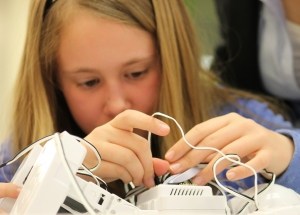Music, Math and Robots: Challenging Traditional Education
4 Min Read • Arts Integration
Education is at a cross roads as it faces the unprecedented challenges imposed by our technologically advanced, data-driven world. Schools are being challenged with aptly preparing students for a world vastly different from today, unknown to what this world will look like. Innovation, creativity, critical thinking, collaboration and the ability to problem solve will become increasingly important skills for the remainder of the 21st Century.
Challenging Traditional Education
Traditional education brick-and-mortar schooling, a legacy of the industrial revolution, is now ineffective. Not only that, it is inefficient and inadequate when it comes to educating today’s youth. Many North American traditional education systems could stand to take a lesson from Wayne Gretzky. You see, instead of playing where the puck is, Gretzky played where they puck was going to be. In other words, we can’t teach to what we need today. We need to teach for what we need tomorrow. Or even better, we need to teach the ability to adapt to whatever that tomorrow will be. If we continue to play where the puck is, our students will be left unprepared for tomorrow. Furthermore, resulting in our country’s health, wealth and vitality’s suffering. Put simply, the long-standing methods, technologies, and curricula of the past cannot adequately prepare our youth for tomorrow.
Many traditional education systems from around the globe are aware of the increasing need to make a shift and are answering the call by transforming their curriculum and their pedagogies. Finland, a world leader that consistently ranks at the top of PISA scores, just announced they are no longer offering ‘subjects’ in traditional education ways but will instead offer integrated learning themes. In other words, subjects will no longer be separate and siloed; instead they will be enmeshed in ways that connect them to each other, to the students, and to the real-world.
STEAM: The Ideal Integration Technique
Like Finland, many North American educators believe that the integration of subjects is critically important for learning, and I agree. To me, STEAM offers an ideal integration of what were once traditional subjects like math, science and art with new subjects like engineering while incorporating innovative technologies. To many, STEAM traditonal education answers the urgent calls for change as it incorporates collaboration, creativity, creation, critical thinking, problem-solving and playing to learn.
 Touting the importance of STEAM may seem odd coming from a math educator but I truly believe in the power of STEAM, especially in the math classroom. Rich and meaningful STEAM learning experiencesoffer students multiple points of entry into math and educes barriers for many struggling and/or stressed learners. The trick is to find rigorous, meaningful activities where students are truly doing math while engaging in integrated learning experiences.
Touting the importance of STEAM may seem odd coming from a math educator but I truly believe in the power of STEAM, especially in the math classroom. Rich and meaningful STEAM learning experiencesoffer students multiple points of entry into math and educes barriers for many struggling and/or stressed learners. The trick is to find rigorous, meaningful activities where students are truly doing math while engaging in integrated learning experiences.
I believe if we embraced STEAM in the math classroom, not only would students enjoy math, but they would have access to the meaning behind the abstract signs and symbols that are all too often problematic for many of our students. One way I infuse STEAM into the math classroom, is by having students build robots (engineering). After constructing robots, students then program their robot to dance to one of their favourite songs (arts and technology). Not only does this result in high engagement, but students get “mathed” without even realizing it.
They use geometry, spatial reasoning, computational thinking, knowledge of fractions, and problem solving skills in order to program the movement of their robots. In addition to math, engineering, science and technology, this STEAM activity enables students learn about time and space, balance, centre of gravity, and about the timing and tempo of music. Students also learn to be flexible thinkers and make adjustments as they realize the tempo of music changes in a song and problem solve to figure out how to program their robot to move in ways that corresponds with the changing tempo.
In conclusion,
Traditionally siloed subjects, like math and science, leave many kids behind. STEAM offers hope as it can help all kids learn math in ways that are meaningful, engaging, and that make sense to them. By embracing STEAM learning activities in the math classroom, we can make math accessible to all kids. In doing so, all kids will be afforded the advantage of being able to play where they puck is going to be instead of being left behind the play.



